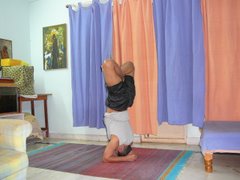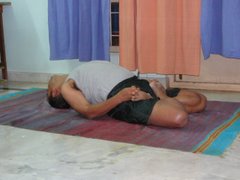Vatayanasana
Vata (n.) = Wind, air, breeze
Ayana (n.) = Direction, Phase
Vatayana (n.) = Window
Asana (n.) = Posture
Now, why this particular Asana is named in this way, I am not sure. Does it have something to do with wind such as Pavanmuktasana has? Not sure again.
Breathing: Inhale as you raise your arm (picture above), exhale as you touch your toes (picture below)
Well, I have given it a practice label, since, I am only tentatively doing forward bends these days. Didn't do it for more than two years - courtesy my back pain. As the back pain recedes, reclaims my forward bend its lost territory. yet, I have miles to go in here too. Not only the finger tip will touch the ground, but the full plain of the palm (karatal)
Thursday, March 27, 2008
Saturday, March 22, 2008
Supta Padangusthasana
Supta Padangusthasana
Supta (adj.) = Asleep
Pada (n.) = Leg
Angushtha (n.) = Thumb
Asana (n.) = Posture
Together the above should mean "Lying big toe posture"
I find this Asana to be one of most difficult in the Padangusthasana series. It really is the graduating Asana in the series. There's only one which I can think of more challenging than or as challenging as this Asana which is Parsha Padangusthasana.
Right Leg
As ususal, I still have a lot to achieve in this Asana (I am just a student :)) - the comfort that I seek while practicing this Asana, I hope would come in about a year or thereabouts.
Left Leg
Breathing: Breathe in as the legs are extended
Drishti: Nasagre
Supta (adj.) = Asleep
Pada (n.) = Leg
Angushtha (n.) = Thumb
Asana (n.) = Posture
Together the above should mean "Lying big toe posture"
I find this Asana to be one of most difficult in the Padangusthasana series. It really is the graduating Asana in the series. There's only one which I can think of more challenging than or as challenging as this Asana which is Parsha Padangusthasana.
Right Leg
As ususal, I still have a lot to achieve in this Asana (I am just a student :)) - the comfort that I seek while practicing this Asana, I hope would come in about a year or thereabouts.
Left Leg
Breathing: Breathe in as the legs are extended
Drishti: Nasagre
Wednesday, March 19, 2008
Naukasana
Naukasana
Nauka (n.) = Boat
Asana (n.) = Posture
Naukasana is also known as Navasana. But the latter, I feel, is a Hindi, and not a Sankrita word.
Hence I prefer to call it as Naukasana
One friend asked me how to do a Naukasana. I assume that it would be in the mind of my visitors too. Well, I have seen multiple ways of doing this Asana. However, the easiest way I find is as provided below:
1. Sit with your back straight
2. Extend both your legs forward as you would when you are doing the Paschimottanasana
3. Place your hands, palm down on yor knees;
4. Breathe in
5. Breathe out and tilt backwards, and extend your arms towards the knees
Nauka (n.) = Boat
Asana (n.) = Posture
Naukasana is also known as Navasana. But the latter, I feel, is a Hindi, and not a Sankrita word.
Hence I prefer to call it as Naukasana
One friend asked me how to do a Naukasana. I assume that it would be in the mind of my visitors too. Well, I have seen multiple ways of doing this Asana. However, the easiest way I find is as provided below:
1. Sit with your back straight
2. Extend both your legs forward as you would when you are doing the Paschimottanasana
3. Place your hands, palm down on yor knees;
4. Breathe in
5. Breathe out and tilt backwards, and extend your arms towards the knees
Sunday, March 16, 2008
Supta Urdha Pada Vajrasana
Supta Urdha Pada Vajrasana
Supta (adj.) = Asleep
Urdha (n./adj.) = High
Pada (n.) = Leg
Vajra (n.) = Thunder
Asana (n.) = Posture
In this pose I am entering into the Supta Urdha Pada Vajrasana. The full Supta Urdha Pada Vajrasana is much tougher, and is not shown here. Let me overcome the challeges in this Vinyasa entry, then perhaps I shall be able to do that Asana.
Supta (adj.) = Asleep
Urdha (n./adj.) = High
Pada (n.) = Leg
Vajra (n.) = Thunder
Asana (n.) = Posture
In this pose I am entering into the Supta Urdha Pada Vajrasana. The full Supta Urdha Pada Vajrasana is much tougher, and is not shown here. Let me overcome the challeges in this Vinyasa entry, then perhaps I shall be able to do that Asana.
Tuesday, March 11, 2008
Vinyasa entry to Karandavasana
Vinyasa entry to Karandavasana
Karandava (n.) = Duck
Asana (n.) = Posture
After nearly a year long practice, Vrischikasana is now kind of comfortable for me. Much much better than what I published about a year ago in this blog. The next step therefore I thought, would be Karandavasana. And the Pincha version of Vrischikasana, both of which I understand are now a couple of years away.
Let me publish my approach to the entry to Karadhavasana.
Any person with a keen eye would be able to figure out that I am just a beginner in this entry. My arms are still not strong enough to hold the balance when the legs have executed a Padmasana.
Now, this I find is one of the most talked about Asana on the Net. I liked Lucas' informal and funny way of talking about Yoga, which hid the spiritual and profound intent of his in the yoga way - the rigour he employs is pretty much obvious in the Asanas he is shown to have executed. Here's his web page House of Lucas.
Karandava (n.) = Duck
Asana (n.) = Posture
After nearly a year long practice, Vrischikasana is now kind of comfortable for me. Much much better than what I published about a year ago in this blog. The next step therefore I thought, would be Karandavasana. And the Pincha version of Vrischikasana, both of which I understand are now a couple of years away.
Let me publish my approach to the entry to Karadhavasana.
Any person with a keen eye would be able to figure out that I am just a beginner in this entry. My arms are still not strong enough to hold the balance when the legs have executed a Padmasana.
Now, this I find is one of the most talked about Asana on the Net. I liked Lucas' informal and funny way of talking about Yoga, which hid the spiritual and profound intent of his in the yoga way - the rigour he employs is pretty much obvious in the Asanas he is shown to have executed. Here's his web page House of Lucas.
Saturday, March 8, 2008
Upavishta Konasana
Upavishta Konasana
Upavishta (adj.) = Seated
Kona (n.) = Angle
Asana (n.) = Posture
Upavesan (v.) = Sit
To me, this Asana is a natural extention of the all Padangushthasanas.
Well, I have a lot of miles to go in this Asana. It is nowhere near the way it should be.
Upavishta (adj.) = Seated
Kona (n.) = Angle
Asana (n.) = Posture
Upavesan (v.) = Sit
To me, this Asana is a natural extention of the all Padangushthasanas.
Well, I have a lot of miles to go in this Asana. It is nowhere near the way it should be.
Thursday, March 6, 2008
Nirlamba Sarpasana
Nirlamba Sarpasana
Nirlamba (adj.) = Without support
Sarpa (n.) = Snake
Asana (n.) = Posture
Quite a few days ago I published the Bhujangasana. Nirlamba Sarpasana is the next step to it.
Everything remains the same - the breathing, the drishti.
Nirlamba (adj.) = Without support
Sarpa (n.) = Snake
Asana (n.) = Posture
Quite a few days ago I published the Bhujangasana. Nirlamba Sarpasana is the next step to it.
Everything remains the same - the breathing, the drishti.
Monday, March 3, 2008
Utthanapadasana
Utthanapadasana / Utthitapadasana
Utthana (n.) = Raising up (not in the sense of bringing up, however - which is nurturing), Rise up
Utthita (adj.) = Raised, Risen
Pada (n.) = Leg
Asana (n.) = Posture
Sometime ago I published the Utthitapadasana, and Utthanapadasana which are what I learnt as a child. The word Utthita has the noun form as Utthana.
Now, I see Utthanapadasana being performed as it is performed in the above picture. Kind of interesting I would say, for it takes in the benefits from Utthitapadasana and Matsyasana both at one go.
For the grammar enthusiasts: Ut = This sound is not a word, it is called Upasarga in Sanskrita grammar - which is close to a preposition. Upasarga adds additional meaning to a word root.
Ut means up.
Thana this word root means place.
All Upasargas preceds a word root to form a word. Here Ut + thana together formed this word Utthana
If you add a different Upasarga, for example aba to Thana it will form Abasthana (n.) = Placement. Similarly Pra + thana = Prasthana (n.) which means to go away.
Again, Abhi+ Ut+thana = Abbhutthana (n.) Germination
Utthana (n.) = Raising up (not in the sense of bringing up, however - which is nurturing), Rise up
Utthita (adj.) = Raised, Risen
Pada (n.) = Leg
Asana (n.) = Posture
Sometime ago I published the Utthitapadasana, and Utthanapadasana which are what I learnt as a child. The word Utthita has the noun form as Utthana.
Now, I see Utthanapadasana being performed as it is performed in the above picture. Kind of interesting I would say, for it takes in the benefits from Utthitapadasana and Matsyasana both at one go.
For the grammar enthusiasts: Ut = This sound is not a word, it is called Upasarga in Sanskrita grammar - which is close to a preposition. Upasarga adds additional meaning to a word root.
Ut means up.
Thana this word root means place.
All Upasargas preceds a word root to form a word. Here Ut + thana together formed this word Utthana
If you add a different Upasarga, for example aba to Thana it will form Abasthana (n.) = Placement. Similarly Pra + thana = Prasthana (n.) which means to go away.
Again, Abhi+ Ut+thana = Abbhutthana (n.) Germination
Subscribe to:
Posts (Atom)
















